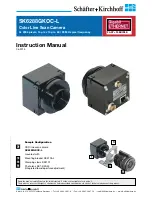
Document:
RE-TCC5 1G0
Document:
RE-TCC5 1G0
Update:
July 2010
Update:
July 2010
Page:
1
Page:
1
OWNER'S MANUAL
RE-TCC5 Color Wired cameras
Product description
RE-TCC5 it is a high performance camera for CCTV applications requiring the highest video
quality. E 'based on CCD Sony Ex-View double SCAN, able to combine high-resolution color with
great night vision capability and wide dynamic range. This model is not suitable for use with
infrared illuminators.
Main features
CCD Sony Ex-View Wide Dynamic Range 1/3 '' high resolution 520 TVL
WIDE DYNAMIC RANGE - The WDR feature that is included in the CCD of the camera
allows a better yield in condition
Backlight where
find part
image more enlightened than others and optimizes the vision in all non-optimal light conditions.
Minimum illumination 0.0045 Lux
Function DSS (Digital Slow Shutter). It allows viewing with minimal lighting, without the use
of IR illuminators. This technology is to hold in memory the video frame and condense them into a
single frame. The refresh time of the image decreases but increases the resilience with minimum
illumination.
vertical and horizontal Mirror function for
the
tilting the image in the backward or shooting with camera upside
OSD (On Screen Display), via programming screen MENU controllable with rear buttons.
Titler for
Stamping number
camera
Connections
Video OUT
BNC connector for video output
Video OUT
BNC connector for video output
DC 12V
Jack for 12VDC power supply
Auto Iris
Auto-iris lens connector
LED
Power LED
OSD
Buttons for control of OSD
BNC video output - Bottom right you connect a cable leading to monitors or management
devices typically using RG59 coaxial cable type and the like, and BNC connector.
Input for auto iris lens - The camera is able to command Direct Drive auto iris lenses.
DC12V - Connect 12VDC power supply by at least 1A with 5.5 mm plug with a positive
central STABILIZED, such as RE-AL4S model
Control buttons - with the central button to access the camera setup menu, with the other
buttons you move between menu items
Fixing - The camera is provided without bracket which must be purchased separately. The
thread for the bracket is available under the camera both above for ceiling mounting
Power to the camera
On the back of the camera there is a connector for the power supply
(POWER).
Need
connect a
12VDC power supply by at least 1A with 5.5 plug
mm. center-positive, as the RE-AL4S model. Attention to use STABILIZED feeders that provide
12V in any load condition. The use of a different supply voltage from 12VDC can generate video
disorders and in the worst cases damage the camera.
If you carried out a centralized power pay attention to too long power cables, which could
introduce excessive voltage drop.
Connect the video
The video output is on the rear of the camera and has a BNC type connector. It must be
connected to the monitor or video management device. If the distance to be covered is a few
meters you can use any type of cable. But if you go over 10 meters we recommend using the
coaxial cable type RG59 or similar which also allows the wiring over a hundred meters.
Attach the lens
These cameras are supplied without lens so that you can equip with the lens more suited to the
size and to the ambient brightness. The attack to the target is C / CS type. The goal must be
purchased separately and is screwed on the front of the camera. If the lens is of the iris type
must be connected to the connector socket to the rear view camera. The camera is capable of
controlling autoiris Direct Drive goals. If you need to bring their own to the connector solder
these are the PIN to use:
PIN DIRECT
1
DAMP - 2
DAMP + 3
DRIVE + 4
DRIVE -
Once the lens is screwed, it is necessary to proceed to the focus adjustment. First, you must
adjust the focal distance from the CCD by acting on the threaded ring nut placed on the camera
body to obtain an acceptable vision. At this point it is possible to refine the vision by turning the
focus adjustment of the lens.





















